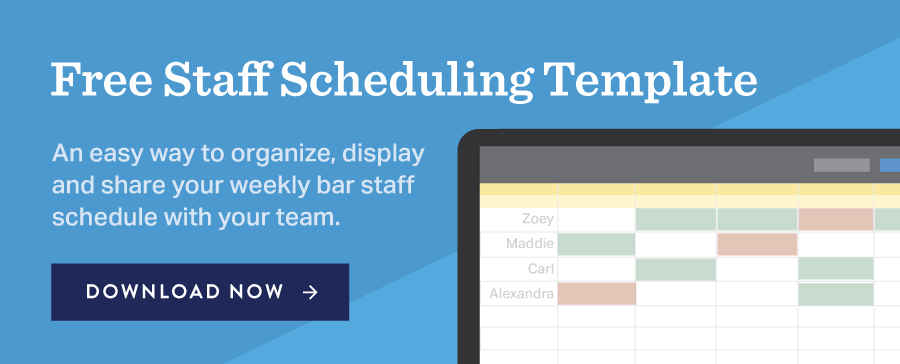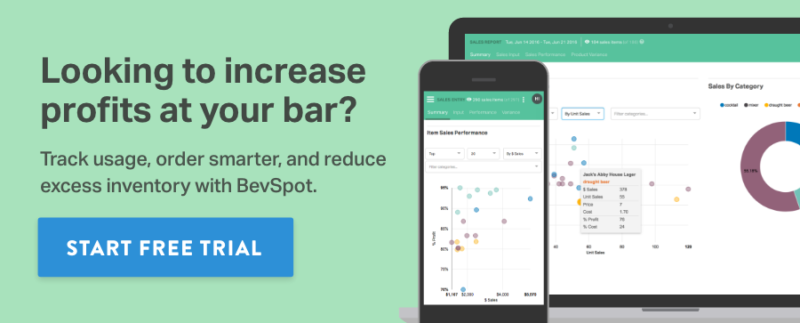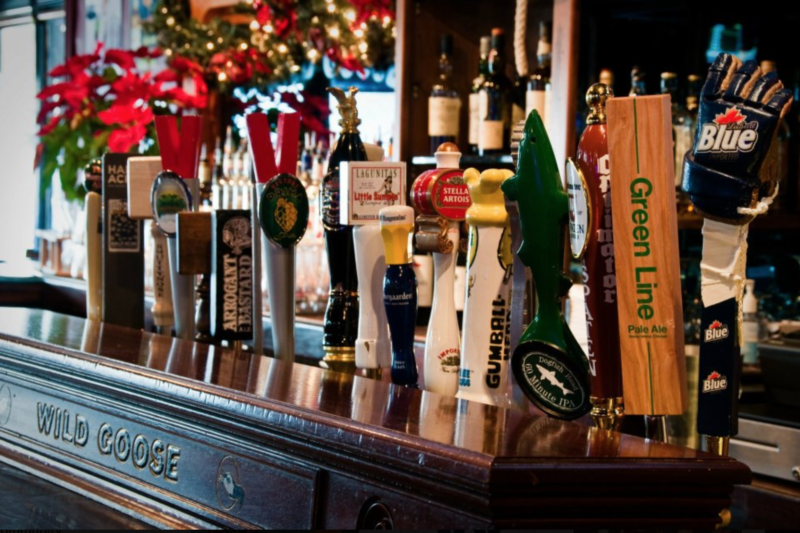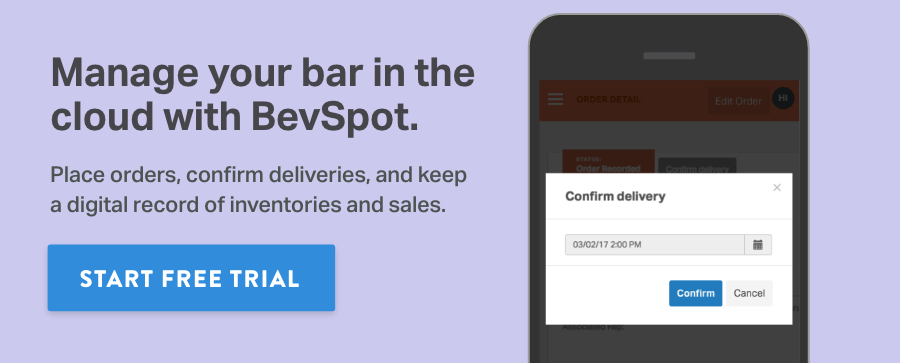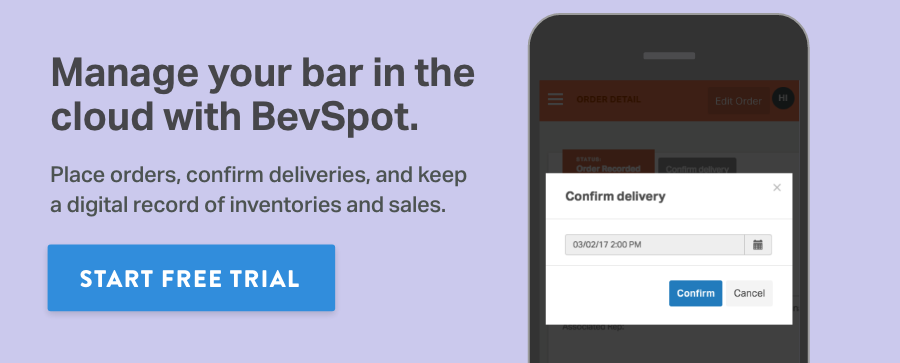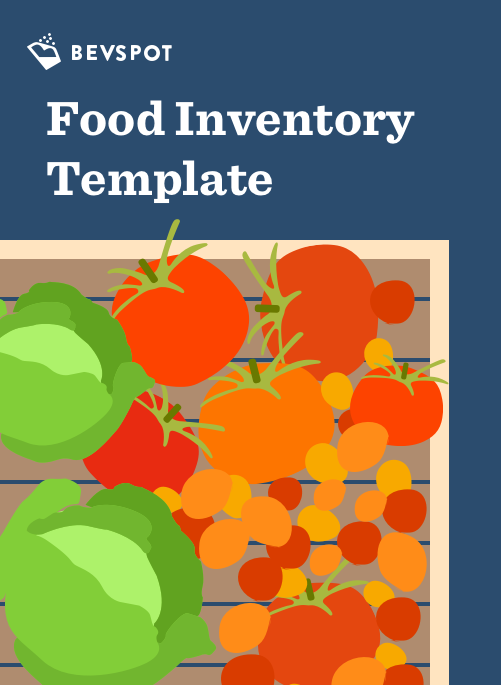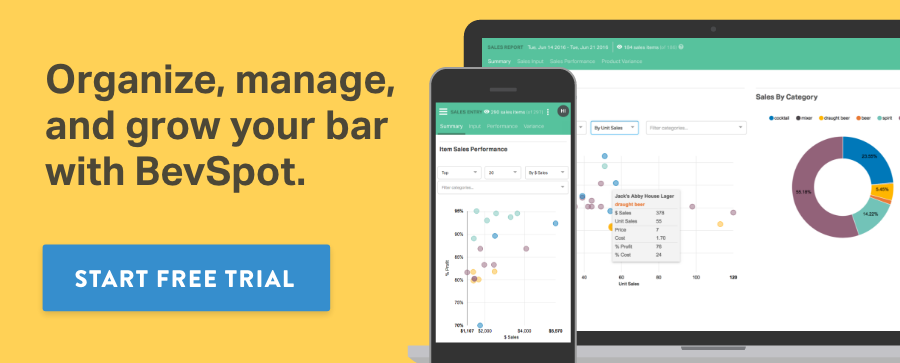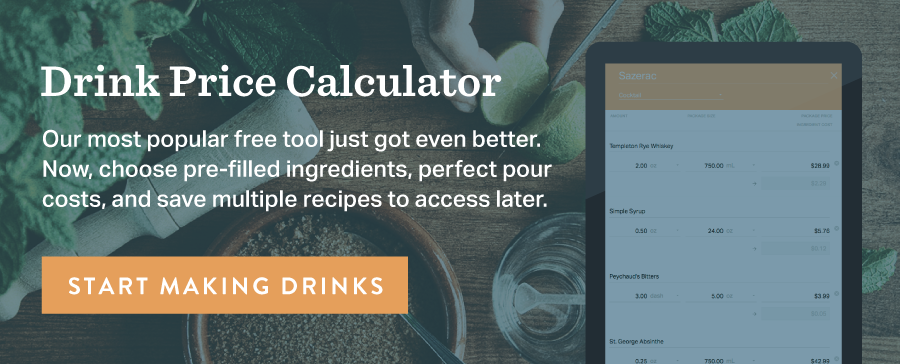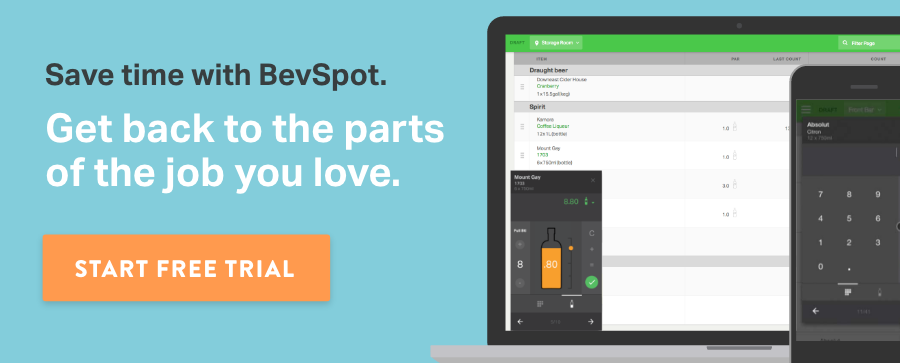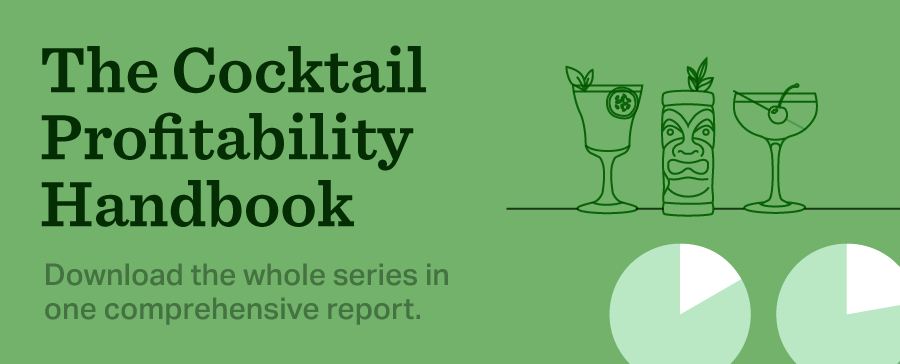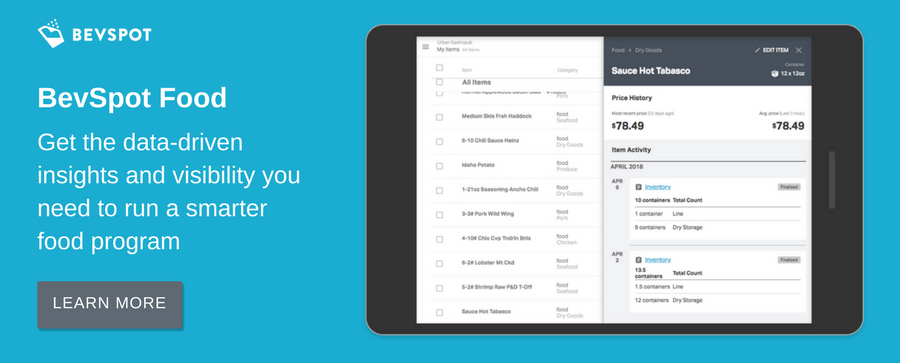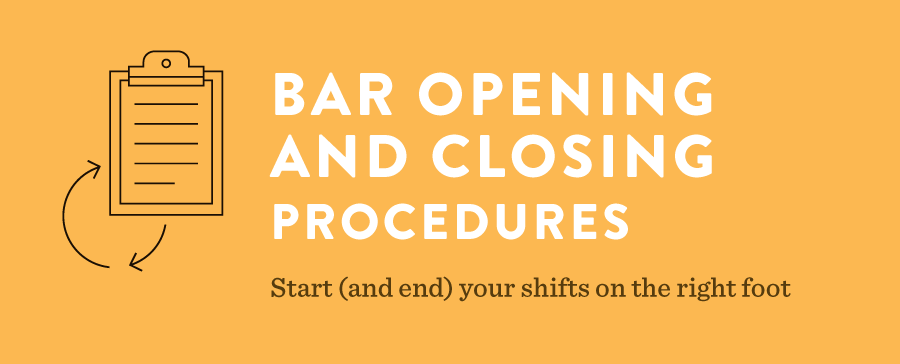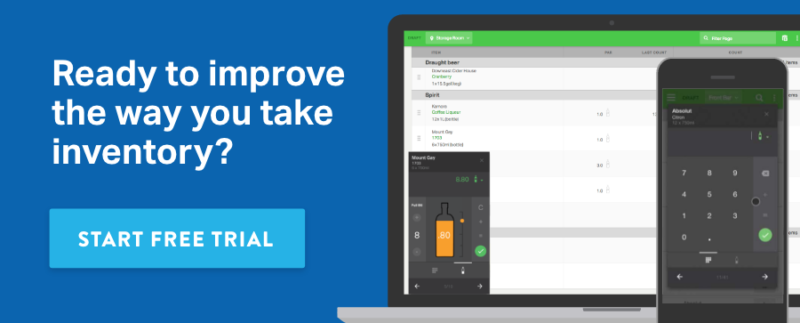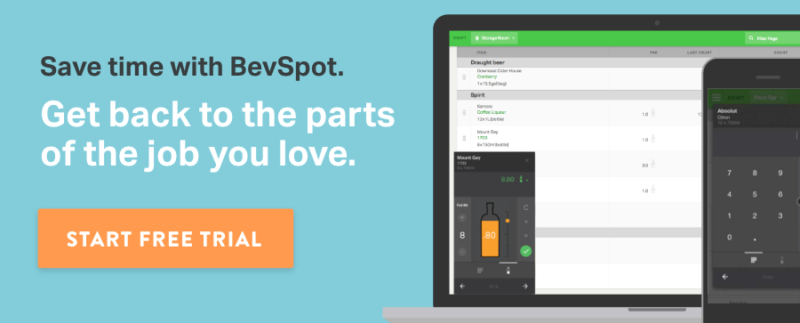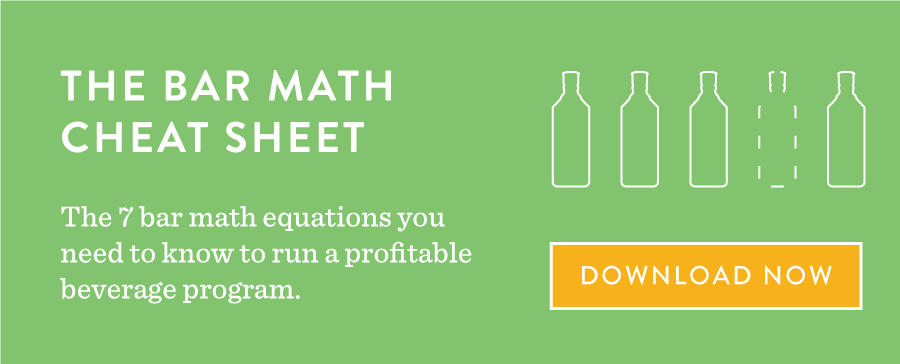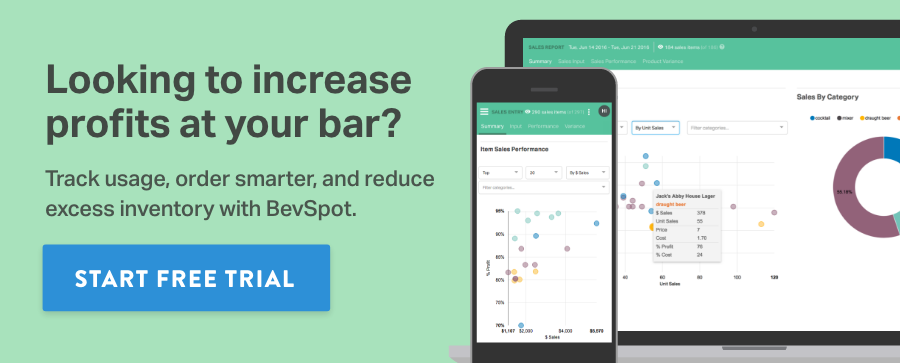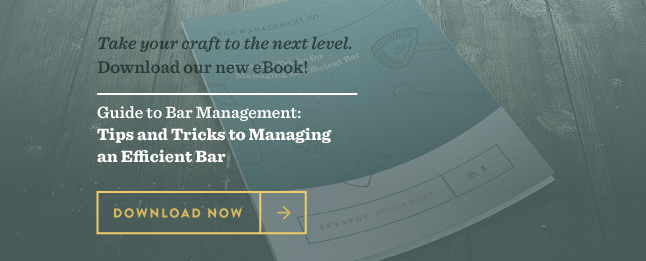6 Skills Every Barback Should Master (And How to Train Them)
The best ways to train up your barbacks for success
On the surface, a barback can seem like a thankless job. Whether they’re restocking the bar, folding napkins, checking off bar opening and closing procedures, or managing bar inventory, it’s certainly not the most glamorous bar gig. But in reality, barbacks are your bar team’s backbone.
Start Your Free Trial With Bevspot Today!
Barbacks are often the least experienced members of your team. But that doesn’t mean you shouldn’t give them the training support they need. Here are six skills every barback should master and how you can train them up.
1. Bar setup and bar breakdown
To educate them on your bar setup, assign them a shift where they get to setup and break down the bar. Learning by doing is a great way to show them your procedures in action.
2. Cleaning and polishing glassware
Have your new barback polish and clean glassware on your bar. This is a great opportunity to educate them on the different types of glassware and when to use them.
3. Running dishes from the kitchen to bar patrons
As support members of your bar team, barbacks are often assigned to run dishes from the kitchen. This will help them learn more about your food program and get acclimated to the flow of a shift.
4. Maintaining the bar during a shift
Whether it’s refills on non-alcoholic beverages or regularly cleaning the bar top, there are many steps of service that a barback can fill during a shift. Taking orders should be limited to your bartenders to prevent miscommunication. However, simple tasks like clearing plates and glassware help barbacks understand how to manage the flow of a guest’s visit.
5. Pouring beer or wine if your bar team is slammed
Learning how to correctly pour beer and wine is a critical base skill for most bartenders, but it’s also a great training tool for barbacks. This might not be appropriate for a new barback, however. Make sure they’re legally of age to serve alcohol and you’re confident with their skill level.
6. Managing inventory and restocking the bar
Product flies everywhere during a busy shift. Barbacks play an essential role restocking the bar. Handling deliveries and inventory organization will teach them where all of your items live on the bar and how much to stock for each shift.
Moving up from barbacking to bartending
By giving your barbacks these responsibilities, you’re building team members who have the skills and understanding needed to run a bar. So, it’s important to have a structure in place for team members who want to move up the ranks.
Schedule training shifts or start them on slower days to avoid overwhelming them. Also try training a new barback and bartender at the same time to make the transition easier for the whole team. When everyone sees the opportunities for advancement, it strengthens the bar team’s morale. Who knows? Your next star mixologist could be the scrappy barback, and it is up to good bar management and training to make that happen.
Schedule 15mins to chat with a product specialist
Start a FREE Trial Today! BevSpot offers full product education and account setup for all customers! No card Information needed!
BevSpot Industry Profile: Andrew Van Ermen
Andrew Van Ermen is one of the owners of Wild Goose in Chicago’s Lincoln Square neighborhood. Van Ermen bought the fun and casual sports bar and grill about 12 years ago.
How did you get started in the food and beverage industry?
I’ve been in the hospitality industry since I was about 13 years old. I’m a graduate of Michigan State University’s Hotel Management program. After college, I worked for several hospitality companies, hotels, restaurant chains, and individual independent restaurants. Over the years, I worked my way through operations, accounting, and technology. My wife and I finally ended up buying Wild Goose and have been running it ever since.
What are the biggest challenges you are currently facing?
As an owner, I did not want to have a day-to-day job at the restaurant. That type of philosophy on ownership comes with certain challenges. The most critical challenge is hiring good people to make sure they execute on your behalf. Another challenge is managing data and information in order to make sure you are minimizing any loss, waste, or theft.
How does technology help you take on those challenges?
Having been in the restaurant business for a very long time, I’ve seen restaurant technology come a long way. It isn’t until recently that I’ve seen it be of really true assistance. Data was usually trapped within the walls of each of your establishments. Now, with technology like BevSpot, the ability to see data anywhere and use it to manage your business enables you to not have to be at each individual restaurant in order to succeed.
In your opinion, what are the greatest opportunities and challenges for the industry in the future?
One of the things I know restaurant owners struggle with is how much effort it is to produce business data. Integrations with a point-of-sale system on a real-time basis is the “Holy Grail” to me. The ability to see sales, inventory levels, and purchases without having to import or export data is where it’s at. It makes your data even more valuable and actionable. I know that can be done with the right technology.
When you’re “off the clock,” what is your go-to cocktail or beverage?
A good glass of red wine.
How to Get Your Bar or Restaurant Insured
Getting insured isn’t exactly the most exciting part of owning an establishment.
Figuring out what insurance you need can be quite a painful and confusing process. But, having the proper bar and restaurant insurance is an essential part of opening a business—especially one that serves food and alcohol. Here’s a quick rundown of the common types of insurance you’ll need for your bar or restaurant.
General liability insurance
General liability protects you and your business from suits from third parties (vendors, patrons, etc.) for injuries sustained or damages incurred on your property. In your case, think someone slipping on a floor, falling off a chair, or getting sick after eating or drinking at your establishment.
When setting up your general liability insurance, make sure to ask how your unique features will change the cost and type of coverage you need. Do you have a pool table or any kind of games? Does your bar or restaurant host the occasional band or offer karaoke? Are you pet friendly? That all affects your coverage.
Property insurance
It’s inevitable; stuff breaks. Angry patrons will shatter the occasional stool. Pipes will burst. We briefly touched upon this in our disaster recovery blog post, but property insurance can help you recover and repair any kind of damage to your building or equipment—and sometimes save an establishment from going under entirely.
There are many categories of property insurance. At the very least, you’ll need to catalogue the model numbers of all your equipment and the values of everything in your establishment. If you know the exact value of what you’re insuring, you can decide if you want insurance that covers replacement of your items, or simply the monetary value of them.
Worker’s compensation insurance
It’s almost a near certainty you will need a Workers’ Compensation Policy. Like property damage, “employee damage” can happen despite your best efforts. Workers’ Compensation will cover anything from medical bills and disability payments, to rehab and prescription drug coverage. Providing a safe work space is a given, of course, but the monetary reminder doesn’t hurt.
Check your state’s worker compensation laws and identify what kind of policy you need. Certain states prohibit private insurance for workers’ comp, while others use an independent board to classify which kind of policy your business qualifies for.
Liquor liability insurance
Separate from general liability, liquor liability concerns damages and events that occur because of drunkenness, or any incidents arising from the use of alcohol. Believe it or not, if a patron of your bar gets into a car accident on the way home, or starts a fight, or even gets removed by a bouncer, your establishment could be the target of both a civil and criminal suit. A liquor liability policy, which is a lawful requirement in most states, protects you and helps cover anything from awarded damages to legal fees.
Beyond the basic insurance types
These four examples are the basic types of insurance needed to protect your bar or restaurant. Consult with your policy provider about any other types of insurance your specific business may need, such as flood or fire insurance.
Not everyone needs or can afford every type of insurance, but if you know how much you plan on insuring, you can find a policy that fits your needs and your price range.
Schedule 15mins to chat with a product specialist
Start a FREE Trial Today! BevSpot offers full product education and account setup for all customers! No card Information needed!
3 Reasons Why Hotel Food and Beverage Is on the Rise
Eating is as critical to the human experience as finding a place to sleep.
I’ve had the pleasure of working with thousands of great hospitality businesses over the last few years. One shift I’ve noticed and heard from our customers time and time again, is the increasing focus on food and beverage within the U.S. hotel space—spending at hotel bars and restaurants grew 5% last year. I recently sat down with three industry leaders to get their perspective on growing trends, the history of hotel food and beverage programs in the U.S., and where they think this evolution is taking the industry.
Hotel food and beverage programs were a luxury, not a basic amenity
Hilton, Hyatt, and Marriott: three massive hotel brands that historically dominated the hotel market. In the past, they were solely focused on driving revenue with their rooms. Food and beverage programs were considered an amenity, not a core competency. Lokesh Singh, who has 35+ years of experience managing food and beverage for various hotels and government agencies explains the breakdown. “40 years ago, things were very different. Food and beverage was not a revenue-producing department for brands like Sheraton. If you broke even, you were in very good shape.”
When hotels did invest in their food and beverage programs, it was often in their banquet and event catering business. Dean Wendel, Corporate Director of Food and Beverage for Concord Hospitality explained how extravagant these events really got. “Going back to the Ritz Carlton in the mid 1980’s, we had large corporations were spending a lot of money on events and conferences. There was seemingly no expense too grand to pull off an event. We were doing single events going for $100k, $200k, and more.”
The U.S. hotel industry was hit hard by the 2008 economic downturn. Between 2008 and 2009, market demand shrunk by 7.5%—a blow felt by everyone in the industry, including Wendel. “Staffing got cut and changes were made to maintain the level of profits…brands like Courtyard and other select service hotels were focused on gaining the profits from rooms. Once we hit 2008, everything kind of just fell out. We had to work twice as hard to capture the same amount of business, and you had to execute flawlessly or you would lose the business.”
Almost a decade removed, things are looking up for the hotel industry. But, with time comes changing tastes and needs. In my experience working with food and beverage directors, I’ve noticed three specific trends most of all.
Third-party management companies are here to stay
Third-party hotel management companies are here to stay. For many brands looking to reinvent themselves, hiring these companies makes sense—their approach to hoteling is holistic, creative, and can be much more dynamic than legacy hotel brands.
These management companies are also increasingly focused on upscale full-service food and beverage projects. In order to compete, these management companies are creating a unique food and beverage core competency and executing their strategy across their portfolio of hotels. That way, every patron gets the same exceptional experience across the brand, regardless of which individual location they’re visiting.
Bridging the economy and luxury divide with lifestyle hotels
Gone are the days when you could only choose between the luxury St. Regis or the economy Best Western. Hotel development in recent years has focused largely on the upscale and upper midscale hotel segments. Between 2013 and 2016, the percentage of upscale rooms under construction grew from 35% to just over 45% of total construction by segment. In 2015, upper midscale peaked at almost 35%.
Meanwhile, luxury and economy has struggled to surpass 5% of all rooms under construction over the same period of time. A big trend driving this mid-tier growth is the proliferation of lifestyle brand hotels, which offer more than a room and a free breakfast buffet. These brands focus on delivering a unique hospitality experience that’s designed to cater to the changing tastes of its guests; something out of the box and unique to the hotel’s neighborhood or community.
Chelsea Melvin, Corporate Director of Beverage Operations for Concord Hospitality says she’s seen this shift in traveler preferences for a while now. “The days of the 1,500 room hotels are gone. I think it’s going to be full-service, smaller, lifestyle-branded hotels.”
A defining feature of lifestyle hotels is their emphasis on food and beverage. “People are focusing on creating lifestyle brands, taking food and beverage to the next level and putting it to the forefront,” explains Melvin. “For instance, The Aparium group from Chicago does a great job with their food and beverage. They just built a hotel called The Foundation in Detroit, Michigan in an old firehouse. Even with the square footage alone, it’s fifty-fifty rooms to food and beverage. They’re really embracing food and beverage and taking it seriously.”
Banquet business is booming (and driving profits)
As competition heats up among hotel segments (and even among hotels and Airbnb) food and beverage is helping properties stand out from the crowd. But, many hotels are still relying on banquet space to drive beverage revenue and profits for the business.
Hotel banquet space offers opportunity to drive significant revenue at much lower costs than traditional restaurants. “If you have a hotel with a minimum of 10,000 sq/ft of banquet space, you can do weddings. You can do social nights,” Melvin from Concord told me.
“If you charge $50 per person for five hours of open bar, and when you go back and do an analysis—sometimes it’s crazy—nine times out of ten, these social events where you’re running an open bar, you’re running at 10%, 9% total cost of goods. That kind of scale and profitability is impossible in a traditional restaurant setting.”
More catering business can also lead to more rooms booked. “Food and beverage is now helping room sales tremendously, which wasn’t the case years back,” explained Singh. Weddings also drive a significant share of hotel catering revenue. The average cost of a wedding in the U.S. jumped to $35,329 in 2016, an all-time high. However, the final price tag varies based on geographic location and evolving cultural norms and traditions. “An average South Asian wedding, for instance, can cost between $75k to $100k. $30k is not necessarily always the average. Regardless of culture or ethnicity, the general idea of the ‘traditional wedding experience’ is changing. As a result, hotels have to keep up.”
Hotel bars and restaurants are setting trends, not following them
If someone is traveling and staying in a hotel, they’re often either working or on vacation. Hotels and food and beverage should live together. It makes sense; eating is as critical to the human experience as finding a place to sleep.
We’re seeing some of the most innovative food and beverage programs coming out of our hotel customers, including The NoMad in New York City and Los Angeles, and The Godfrey Hotel in Boston. We’re not the only ones noticing. In a recent list of the World’s Best 50 Bars, three of the top five are hotel bars. Consistent guest foot traffic combined with more square footage for events, enables these programs to carry more inventory and experiment with larger programs, all while maintaining industry-leading profitability levels.
Hotel management companies are also taking new steps to grow their corporate food and beverage teams to keep up with their growing number of full-service properties. When I asked Wendel from Concord Hospitality how hotel kitchens are evolving, he emphasized how important it is to not only hire the right people, but make sure they have the tools and support to be successful. “We’re making sure we have the right equipment in place to execute our product goals. Most importantly, we are hiring great leaders and staffing correctly.”
Food and beverage isn’t the afterthought, it’s the focus
Hotels are a vital piece of the hospitality industry, but I believe that food and beverage is now just as vital. Changing consumer preferences and the growing full-service market has provided hoteliers with a unique opportunity to differentiate themselves through their food and beverage programs.
Schedule 15mins to chat with a product specialist
Start a FREE Trial Today! BevSpot offers full product education and account setup for all customers! No card Information needed!
Restaurant Inventory: Sources of Food Waste and How to Prevent It
No one wants to think about food waste, but it’s there.
Food waste can quickly become any restaurant’s forgotten cost. According to the National Restaurant Association, four to 10% of food purchased in the U.S. is tossed before even reaching a guest. Here are five of the most-common sources of food waste and practical steps to improve restaurant inventory management.
1. Over-ordering
Over-ordering product happens for a number of different reasons. The most common reason? An inefficient or improperly managed restaurant inventory system, which can easily lead to chefs ordering more product than actually necessary. Performing and tracking inventory regularly will keep food waste down and save you money on ordering food that you just don’t actually need.
2. Spoilage
Even if you aren’t over-ordering product, you run the risk of spoilage. If you don’t carefully inspect the food coming in, you might accept product that is already turning bad. Make sure to clearly label all incoming product with best-by dates. Labeling enables you to install the first-in, first-out (FIFO) storage method to reduce the amount of spoiled food you keep on hand.
3. Overproduction
Another common source of food waste is overestimating sales for a dish. Chefs often will prep and cook too much food to avoid 86’s. But, this leads directly to higher food waste. Tracking sales gives you a chance to periodically review your menu, create more efficient batching levels, and even eliminate dishes that aren’t moving fast enough. Try planning your staff meal around your extra ingredients to save the sunk costs of prep work.
4. Assorted misfires
A server forgets to add the allergy note for a dish including nuts. A line cook misread a ticket and prepared the wrong dish. Misfires can kill your bottom line. Proper training and active management can prevent these types of mishaps from happening during a shift.
5. Poor portion control
Do you throw away bags of untouched food every night? This could be a sign that your portions are off. Effective portion control means you can stretch your food budget further without sacrificing quality. Standardizing your measurements for each dish can prevent too much food reaching the trash when a guest doesn’t feel like packing leftovers.
It’s impossible to control food waste completely. That doesn’t mean you can’t drastically reduce the amount of waste you produce by taking a few simple precautions. This keeps money in your pocket, food out of the trash, and makes your kitchen better, too.
BevSpot can help
BevSpot’s restaurant inventory app helps with food/beverage management for inventory, ordering, invoicing and access to your establishment’s critical sales data. So, you can grow your business faster—from anywhere. Our customer success team will help set up your account so you can improve your restaurant inventory software immediately.
Schedule 15mins to chat with a product specialist
Start a FREE Trial Today! BevSpot offers full product education and account setup for all customers! No card Information needed!
How to Use Herbs in Your Cocktails (and Save Money Doing It)
Herbs can make or break a cocktail.
Whether it’s crafting a toddy with fresh ginger or creating your own basil simple syrup, more and more bar programs are incorporating herbs and spices into their cocktails. Using the products already available in your kitchen not only encourages creativity, but it’s also a cost-saving move that strengthens the partnership between your back and front of house. There a few simple ways you can use herbs in your cocktails.
Garnish is not just for the plate
The most common way to incorporate food items into cocktails is using herbs for garnish. Remember, even if a specific herb isn’t in the drink itself, that doesn’t mean that you can’t use it. A simple herb sprig can tease the nose and boost the aroma of a drink.
An easy way to save money on herbs is to build your own in-house garden. By limiting your staff to using what is grown in your garden, you push them to think creatively about their drinks. It also encourages your bartenders to create beverages that complement your food menu.
Muddle, but use caution
If you’re not using herbs to garnish, you’re probably muddling them while crafting a cocktail. But, you can have too much of a good thing.
Carefully tap the herb with the muddler just enough to release the oils from the leaves, not crush it to pieces. Too much pressure can make an herb taste earthy and lose its delicate flavors and aromas. Also make sure you’re using the correct glassware so you don’t break the glass in the process.
Herb-infused syrups pack a punch
If you’re already garnishing your drinks with herbs, consider creating your own infused or macerated spirits and syrups.
Work with your kitchen to find food items, and even food waste, that you can use. For example, you can create oleo-saccharum using leftover citrus peels. This gives your bar a fun, tasty syrup to use in various cocktails and reduces food waste at the same time.
Whether it’s a classic lime cordial or a balsamic-red wine reduction, challenge yourself and your bar team to find ways to mix the kitchen with the bar. Your menu will not only be more innovative, but it will be more profitable too.
How to Create a Profitable Bar Snack Menu
A dynamic snack menu will complement your drinks and keep your clientele coming back for more.
Bar snacks are a staple around the world. Offering snacks at the bar delights guests, increases their length of time at the bar, and their overall spend. But not all menus are created equal. There are a few things to keep in mind when creating a memorable and profitable bar snack menu.
Does my bar snack menu compliment the restaurant?
Your food menu should center around a core conceptual theme, with seasonal variations and rotating specials existing comfortably under a constant thematic umbrella. The same goes for your snack menu. Make sure you stay true to that central theme and also consider:
- The type of space you’re in and its décor
- Resident cultural heritage or regional specialities
- Keeping it fresh by featuring local and seasonal ingredients when possible
Are my flavors cohesive?
When crafting snacks, your team will want to get creative. But, creativity shouldn’t turn into a hodgepodge. Make sure you aren’t combining flavors that simply don’t go together. Cohesion between your bar team and your kitchen team is key for keeping flavors consistent. Some examples of snacks to consider or build off of include:
- Twists on traditional bar snacks or comfort foods, like pretzels or beer nuts
- Cured meats, pâté, and cheeses (à la The Eddy)
- House-made pickles or stuffed olives
How can I make my bar snacks profitable?
Most importantly, you want your snack menu to be profitable. One way to do this is to stay on top of your food inventory and feature items that won’t spoil quickly. Ingredients with a longer shelf life let you stock less and avoid pressuring your bar team to aggressively sell a menu item. You should also research your clientele’s preferences and strategically choose snacks that fit both their desired flavors and price points in order to boost sales.
Schedule 15mins to chat with a product specialist
Start a FREE Trial Today! BevSpot offers full product education and account setup for all customers! No card Information needed!
Accurately Calculate Keg and Bottle Weights with BevSpot
Taking inventory is at our core, so we’re always searching for ways to help you do it faster and more accurately.
Calculate keg weight in BevSpot
Weighing kegs is a challenge. We’ve written extensively about how to weigh kegs, and even created a keg weight calculator to make converting weight to volume simple. Now, BevSpot does the math for you.
Enter the weight of your keg into the inventory counter, and BevSpot automatically determines the volume of liquid using industry standard values. Starting today, this feature is available for all BevSpot users on any package.
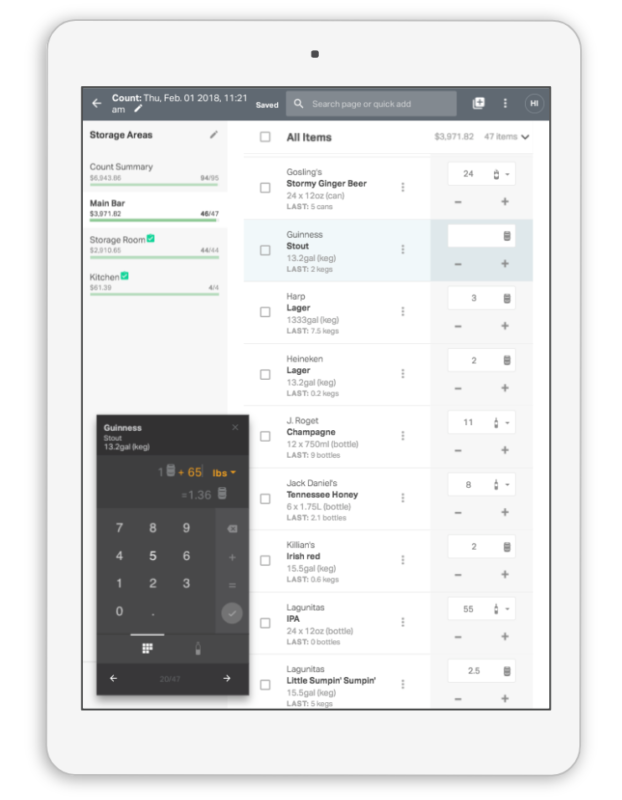
Weight calculations, for bottles too
Bottles may not be as standardized as kegs, but BevSpot can now weigh those too. We’ve collected the average empty and full weights of bottles across a wide range of products, so you can start calculating bottle weights right away. If you’re looking for down-to-the-ounce precision, you can record the empty and full weights of your bottles in the inventory counter within BevSpot, so you get the most accurate measurements.

Starting today, bottle weighing is available for all of our Standard, Pro, and Enterprise BevSpot packages.
See bottle weights in action in the Help Center now!
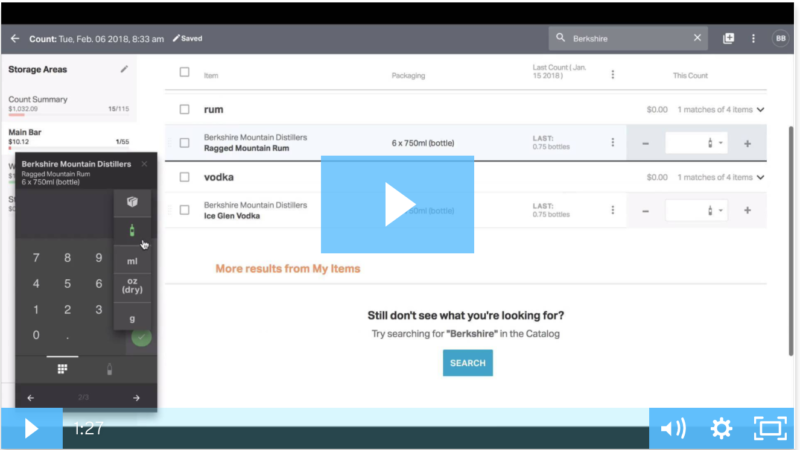
Have ideas? We’d love to hear from you
We built these features based on your direct feedback. Let us know what you think in the comments below, or drop us a line feedback@bevspot.com.
Schedule 15mins to chat with a product specialist
Start a FREE Trial Today! BevSpot offers full product education and account setup for all customers! No card Information needed!
How to Choose the Best Staff Meal for Your Team
A well-fed staff is not just a happy staff, but a more efficient one.
One standout benefit of working in a restaurant is the close proximity to excellent food. Some of the best meals I’ve ever had came from my time working at a restaurant and enjoying staff meals: pre-service plates loaded with delicious food courtesy of the chef. We dissect three variations of the staff meal and explore how you can choose the right one for your team.
What’s a staff meal?
The concept of a staff meal is pretty self-explanatory—a free meal given to the entire staff, usually before service. While it is considered a perk, it can have a definitive impact on your establishment’s turnover rates and staff effectiveness.
That doesn’t mean that all staff meals are created equal. There are stories all over the foodservice industry of these meals consisting of food that’s going bad or day-old foods that really shouldn’t be served at all.
Even if you are serving leftovers, this meal shouldn’t be an afterthought. This is an internal event for your team and should be treated with the importance it deserves.
The benefits of shared food
The immediate benefit of the staff meal is the team building effect it has. As you probably know, nothing brings people together like food. It invites conversation and creates connections. Everyone in food service has a work persona, but when you’re in a situation outside of work, it’s simply easier to break down the barrier. Studies show that a team that works together, shares knowledge, and has a cohesive team culture performs more effectively. When they know and can rely on each other, your establishment functions better.
Approaching the staff meal
There are several ways to go about choosing a staff meal, each with their own benefits and drawbacks:
- The leftovers: We’re not talking about picking food off of people’s plates, but more specifically, this will usually cover the food not used either when made in large batches or prepped out before a shift. The food takes no extra prep time and it’s already paid for—two big perks of this staff meal style. The downside? The meal feels a little less special since it hasn’t been prepared specifically for the staff.
- Education: If you want to provide a little training, an educational meal is another way to go. During education meals, the entire staff is served items on the menu, or off-menu specials that your restaurant will be serving or are experimenting with. Chefs take time to describe the dish and make sure that servers and bartenders know all the talking points to hit when describing specials. It’s important to remember that the food will come out of your pantry and you won’t see any money coming back. Costs aside, it’s an interactive and enticing way to train. You may also be able to deduct the cost as a business expense for superior service.
- Family meal: One of the most loved types of staff meal is the exclusive meal, or family meal. Oftentimes, the chef in charge of preparing the meal will rotate through the kitchen staff. This meal isn’t about menu education. It celebrates team camaraderie and builds a spirit of togetherness, hence the moniker of “family meal.” Unlike leftovers, the meal costs both money and time—money spent on the ingredients and kitchen time spent to prep and prepare. While the benefits may not be tangible, a happy, hard-working staff is worth every penny.
The lasting rewards of a good staff meal
A staff meal isn’t required of an employer. It isn’t in any manual of rules or regulations. But going the extra mile for your team counts for a lot. It lets your staff get to know one another better, to gel into a more cohesive unit, and have some fun. It lets you train your staff in a practical manner that’s fun and different, test new dishes, or showcase a staff member’s talent in a low-risk environment. If nothing else, it gets rid of that food in the fridge that’s about to go bad, doesn’t it?
Schedule 15mins to chat with a product specialist
Start a FREE Trial Today! BevSpot offers full product education and account setup for all customers! No card Information needed!
Bar Opening and Closing Procedures: A Checklist
As a bartender, I’m sure you can create some pretty great cocktails, but what happens when you’re thrust into a Bar management role?
Making a New York Sour is one thing, but coming up with processes and procedures for an entire bar team is a different set of skills altogether. First things first, you need to make sure you have clear opening and closing procedures for the bar.
Building out this repeatable checklist will keep your bar staff accountable, but more importantly, it creates a highly functional and professional environment.
Start Your Free Trial With Bevspot Today!
Bar opening checklist
These don’t need to be done in this specific order, but all must be completed prior to opening to ensure a smooth shift.
-
Clock in
Ice
- Melt any remaining ice from the prior night with hot water
- Wipe out sinks/bins/wells that contained old ice
- Fully stock your ice bins with fresh ice
Fruit & Garnishes
- Cut all fresh fruit needed for garnishes and making drinks (limes, lemons, etc.) and display in clean containers
- Check dates on remaining fresh-squeezed citrus juices
- If older than two days, discard
- Squeeze fresh citrus juices (if needed)
- Based on current cocktail menu, stock any other necessary garnishes (fruits, herbs, cherries, olives, etc.) in clean containers
Stocking Up
- Take note of what you’ll need for backstock of liquor, wine, beer, and mixers
- Stock your shelves, fridges, and wells behind the bar
- Check on keg levels and make note of what might ‘kick’ during the shift
- If necessary, have a backup keg ready to go and inform management and the rest of the staff about the possible change
Cleaning & Setup
- Set up any service bars for drink service with bar mats, speed trays, straws, picks, stirs, bar tools, etc
- Wipe down the bar top and stools with sanitizer and let air dry
- Polish silverware for service
- Fold napkins or create roll-ups with polished silverware and make sure you have enough for each bar seat for opening, plus two full turns of your bar seats
- Get into uniform and make sure you have a speed opener, wine key, pens, and a lighter on hand
Bar closing checklist
These don’t need to be done in this specific order, but all must be completed prior to opening to ensure a smooth open for the next day.
Cleaning & Breakdown
- Wipe down any bottles you have used throughout the shift with a clean, warm towel
- Place any remaining fresh fruit/juices into to-go containers labeled with that day’s date
- Wipe down your draught beer towers with a clean, warm towel and use a keg-line brush to clean out the ends of the taps themselves
- Wipe down the bar top and stools with sanitizer and let air dry
- Cap each tap with a rubber faucet cap to protect overnight
- Put any remaining garnish into their original containers, or clean to-go containers labeled with that day’s date to store until the next day
- Gather any remaining dirty linen (napkins, rags, etc.) and discard in the linen bucket
- Take out all trash and recycling, leaving bins empty
- Break down your service bars, and run everything through the dishwasher (garnish containers, shakers, jiggers, etc.)
- Take a proper inventory by hand or with a bar inventory app.
Stocking Up & Resetting
- Stock your fridges with any spirits, beer, or wine that would need to be chilled before the next service
- Place all unused linens and/or silverware roll-ups into a bin or cabinet to be used again
- Stock the walk-in with any kegs that may need to be chilled before the next service
-
Clock out
Schedule 15mins to chat with a product specialist
Start a FREE Trial Today! BevSpot offers full product education and account setup for all customers! No card Information needed!
Want to Create an Incredible Cocktail Menu? Look to Your Kitchen
There was a time when the front of house and back of house didn’t do much other than pass plates and make small talk.
In my first bartending gig, we didn’t interact with the kitchen. The food menu was created by one person, the drink menu created by another. Food and drinks never paired together. All restaurants and bars have their own personal style, but the ones that deliver the best experience create complementing food and beverage menus. Here are a few examples where bar managers are utilizing their resident chefs in the kitchen to create incredible cocktail menus.
Bringing kitchen techniques behind the bar
For bars looking to dive further into the culinary world, look no further than Chicago’s The Aviary. The Aviary is a bar started by chefs and it shows—bartenders work at stations set up like those you’d find in a kitchen.
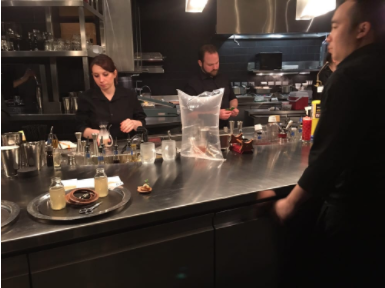
Bartender (or “bar chef”) Nigal Vann embraces the similarities between The Aviary’s bar and a traditional kitchen.
“We get to play with a lot of tools, making tinctures, using sous-vide…what we do goes beyond the glass. I don’t want to say our founders started it, but they are known for it.”
These back-of-house techniques educate and elevate bartenders’ skill set well beyond a traditional bar training, and allows them to explore new creative avenues for cocktail creation.
Saving costs with cooperation
Cocktail programs like the Aviary’s are a first in back-of-house exposure. But, even in less cocktail-savvy bars and restaurants, you’ll likely find fresh juice and syrups. Of course, fresh product can be costly for businesses whose budget is limited. This cost is only compounded for those that don’t make sustainable use out of that product.
Natasha Mesa, head bartendress of Raven and Rose in Portland, OR, stresses the benefits of using product sustainability to avoid waste.
“When the kitchen and bar work together, you find more use for a single ingredient. For example, the kitchen may use the grapefruit supremes, and the bar would use the peels for citrus cordial or oleo.”
If your kitchen and bar aren’t communicating about ingredients and you’re losing money to waste, encourage them to find more creative ways to use the same product.
Refining your bar’s flavors with the help of your chef
For Erin Jones of Coquine in Portland, the kitchen is always part of how she operates her bar.
“My experience behind the bar is driven by my back-of-house experience. I try to build flavors in a glass the way a chef would build flavors on a plate. Look at what is in season, what flavors work together and how can I make that interesting.”
Erin frequently updates her Instagram with pictures of what she’s harvested from her garden and brought to life at Coquine. For bar managers who are less back-of-house savvy, it’s always a good idea to pick at your chef’s brain. Erin still does this regularly.
“I work with Katy (Coquine’s chef) on lots of drinks. When I get stuck or need an inspiration boost, I go to her about how to make ideas happen: how to work out a particular items, for a garnish idea, or how to source something, what’s in season, etc. She and the pastry chef, Lauren, are great resources for me.”
Bringing your kitchen and bar together
Even if you aren’t located in a city like Portland or Chicago, it is possible to get your kitchen and bar working together. Establishments everywhere are giving way to this new approach to operating. Why? It’s cost-effective, boosts employees’ creative juices, and expands the abilities of your entire staff.
Erin put it well, “It’s a symbiotic relationship. You need to have that back and forth to be successful on both sides of the line. This creates a more cohesive guest experience.”
How are you bringing your kitchen and bar together to change the guest and employee experience?
Is Bottle Service Worth It? The Costs and Benefits
Bottle service can rake in money, but at what cost?
There are so many things that make up a nightclub’s culture—from the quality of the drinks to the bartenders’ personalities, to the level of service. Providing bottle service is one way to create a sense of exclusivity. But, is bottle service worth it? We explain the costs and benefits of bottle service that is the nightclub staple.
The costs of running bottle service
Running a bottle service comes with more than financial costs.
- Physical space: You’ll need an area for the private tables with clear, set boundaries.
- Staffing: Each table will require an exclusive server for pouring and suggesting upsells, so you may need to invest in more servers and bar managing to meet the demand. Since bottle service operates on a “minimum spend” amount, more drinking can lead to rowdy behavior. A dependable security team is also a necessity.
The benefits of running bottle service
While it can be costly, there are also benefits of offering bottle service at your bar or nightclub.
- Guaranteed sales: The minimum spend cost guarantees a set, minimum profit amount per table each night. If you have a staff that can create a fun atmosphere for your guests and can upsell with ease, your tables will be booked week after week.
- Increased profits: Because it’s billed as a premium service, you can afford to set your bottle prices high. This will protect your bottom line, even when a table only spends the minimum.
- Show off your service: Bottle service lets patrons skip the lines and avoid the frenzy at the bar. By placing a dedicated server at each table, they can spend a little extra time creating a fun and inviting atmosphere for your guests, talk up different products, and hopefully increase sales past the minimum.
Special concerns and cares
Offering bottle service is definitely an undertaking that shouldn’t be taken lightly. As always, safety should be number-one. Keeping an eye on customers keeps your patrons and staff safe. With preparation, caution, and enthusiasm, bottle service can be a lucrative and fun addition to your business.
Schedule 15mins to chat with a product specialist
Start a FREE Trial Today! BevSpot offers full product education and account setup for all customers! No card Information needed!
Bar Inventory and Usage for Beginners
Bar Inventory and Usage for Beginners
How to count your bar inventory more efficiently!
We care about accurate bar inventory counts—really.
That’s why we make tools to make processes like inventory easier.
- Free Trial, No Card Needed
- Free Consultation and account Setup
- Training sessions offered following Setup
Taking inventory probably isn’t the favorite task of any bar-back, bartender, bar manager, or bar owner. However, inventorying your liquor, beer, and wine doesn’t have to be archaic, disorganized, or time-consuming.
We’ll walk you through the entire inventory process—from counting bottles and cans at the front bar, to measuring kegs and cases in storage—using either a spreadsheet or your BevSpot account. Lastly, we’ll teach you how to calculate usage during an inventory period. This will help you get smarter about ordering new product.
Whether you’re implementing your first inventory system or want to improve your existing method, this six-step beginner’s guide will give you clear answers and tools for understanding your inventory. Let’s get counting, shall we?
Try BevSpot Inventory today with a Free Trial. Or, if you’re not ready to create an account yet, give our free inventory spreadsheet a try. Then, come back and follow these steps. Go ahead, we’ll wait here.
First: Understand why inventory matters
Taking inventory is important for maintaining a stocked bar, of course, but it also identifies:
- How your bar is performing financially
- What your product variance is and where your shrinkage is coming from
- How to set pars for each product
- What your pour cost should be for each product
- Which products sell well, and which don’t
Step 1: Get set up at the front bar
The first step is to get things organized on a computer, tablet, or smartphone. Pull up a blank spreadsheet or open a new inventory count in BevSpot. In your spreadsheet, designate columns for alcohol type, brand, name, bottle size, and storage area location. In BevSpot, create a storage area called ‘Front Bar.’ The rest of the categories are already created for you.
Although you probably store alcohol in more than one location, let’s start at your front bar.
Pro Tip: If you ultimately want an alphabetical list, you can filter your spreadsheet or BevSpot account later.
Spreadsheet vs. BevSpot
Spreadsheet: Separate your products into spirit, wine, and beer categories by sections of rows.
BevSpot: BevSpot will sort products into categories for you and works great on mobile devices.
Input your products to correspond with the order your alcohol is positioned in the front bar and the order in which you plan to count it. This will help you save time when counting.
Step 2: Start counting at the front bar
Once your spreadsheet or BevSpot inventory count is populated with your bottles in the correct order, it’s time to start counting.
We recommend counting bottles using the “tenthing” method. Inspect each bottle and note how much liquid is left inside, separating it visually into tenths. For example, round a bottle that is a third of the way full to 0.3, or 30% full.
Repeat this for each bottle at the bar, including spirits, wine, bitters, etc. Count cans and full bottles as single units.
Pro Tip: Your inventory counts will be easier and more consistent if you start and finish counting while the bar is closed.
Pro Tip: Take note of any major spills or breaks to separate these from how much has been poured. In BevSpot, you can log spills as soon as they happen.
Spreadsheet vs. BevSpot
Spreadsheet: Take a look at your bottle and round to the nearest tenth in your spreadsheet.
BevSpot: With BevSpot, you can use the bottle slider and input calculator for faster inputs.
Step 3: Count kegs, cases, and bottles
Once you’re finished with the front bar, repeat steps one and two for your back bar, walk-in, storage room, or any other parts of the bar where alcohol is kept. In your spreadsheet, add another column for each additional storage area. It’s likely that these areas will contain kegs, cases, and wine bottles. Here are the best methods for counting these items:
Kegs
Estimate a keg’s fullness with a flow meter or the “kick and shake” method. Convert this number to a percentage and enter it in BevSpot or your spreadsheet. Or, with a scale and a standard-sized keg, enter the weight straight into BevSpot or your spreadsheet. BevSpot will convert your weight to a fullness percentage.
- Weighing
- Tenthing
Cases
Whether you have a case of liquor bottles or a case of beer cans, it’s better (and more common) to count cases by the number of individual units they contain. Make sure to combine full cases and stray cans or bottles in your count.
- Single-serve
- Multi-pour
Wine bottles
If you sell wine by the glass, it’s best to use the “tenthing” method we used for counting liquor bottles. If you sell wine by the bottle, count by full bottles and combine with cases.
- Sold by the glass
- Sold by the bottle
Pro Tip: Keep product separated in columns for different storage locations in your bar, or different BevSpot storage areas.
Step 4: Add up your inventory totals for each product
Now that you’ve counted all the alcohol in your establishment, it’s time to add up the totals for each item across locations. This will help you calculate how much product you’re using. BevSpot does this for you, but if you’re using a spreadsheet, calculate the total for each product by adding the totals in each location column.
Pro Tip: Make sure to also keep track of any product you receive between inventories (you can do this with your order invoices). This will be necessary for step six, where we’ll calculate usage.
Spreadsheet vs. BevSpot
Spreadsheet: Make sure you get your formulas right in your spreadsheet.
BevSpot: BevSpot adds your totals for you, while maintaining counts for each storage area. Get a full view on your count summary page.
Congratulations, you finished your starting inventory count! You’re done for the day. You’ll need to come back in a week, two weeks, or a month, to take your next inventory. You should decide in advance how often you will take inventory and make sure to keep them consistent.
Pro Tip: For most bars, we recommend a weekly inventory count for accuracy.
Step 5: Take your second inventory
After some time has passed—a week, two weeks, or a month—take a second inventory by repeating steps two through four. It’s best to do this in the exact same way as before, either in a new spreadsheet or in a new BevSpot inventory count.
Your first count is the “starting inventory” and your second count is the “ending inventory,” the beginning and end of your first inventory period. Having a start and an end will allow you to determine your usage (more on that next).
Pro Tip: Take your count the same way every time. If you counted from left to right during your first inventory at the bar, you should always count left to right.
Step 6: Calculate usage
Now that you have a starting and ending inventory count, as well as a record of any product inventory you received during the period, you can calculate usage.
BevSpot can really help here: we’ll calculate usage for you. If you’re still using a spreadsheet, create a new sheet with the following columns: type, brand, name, bottle size, starting inventory (total of all locations from your first inventory), received inventory (all the product you received during the period), and ending inventory (total of all locations from the second inventory). Use the basic formula below to find this period’s usage.
Pro Tip: Save a ton of time and eliminate all the math by using BevSpot. As soon as you’ve got two finalized inventories, BevSpot will calculate usage for you at item-level.
Spreadsheet vs. BevSpot
Spreadsheet: Make sure your formulas in your spreadsheet are set up correctly.
BevSpot: BevSpot automatically calculates usage based on your starting, received, and ending inventories. See your product usage numbers on your count summary page or dig deeper in a usage report.
The takeaway
Hopefully, you now have a better understanding of how to take inventory and calculate usage at your bar, and why they’re both important. Happy counting!
We can compare spreadsheets and BevSpot side by side, but only one is guaranteed to save you time and money. Start a free trial today to experience faster inventory, integrated ordering, and automatic usage calculation.
Ready to change the way you take inventory?
How to Adapt to the New Mall Restaurant Landscape
Customer habits are shifting away from traditional malls. Are you staying ahead of the curve?
When I began bartending a decade ago, I remember big shopping days like Black Friday and New Year’s Day were absolutely bananas every year. We couldn’t sling drinks fast enough to the nearest person balancing their wallet and five bags filled with presents for loved ones. Sadly, as online shopping increases, customer presence in malls decreases. This decline in brick and mortar traffic directly impacts the bars and restaurants located in malls. How can restaurants adapt to the new mall restaurant landscape?
Track your data
If you aren’t tracking your sales numbers, you’re doing your business a severe disservice. When are you busiest? Slowest? Are there particular seasons when sales are rising or declining? Your data will give you the most accurate way to benchmark the health of your business.
Keep up constant communication
This data will also help you schedule wisely and keep proper inventory pars. It’s important to have a discussion with your staff about what the changing trends mean for your bar/restaurant, especially how that might change their work schedules.
My current employer includes updates on how the holidays will affect schedules, transportation, etc. in our scheduling emails. This steady line of communication is necessary for team cohesion and setting the right expectations. As with any relationship, communication is key.
Change your marketing and sales tactics
Part of what makes bars and restaurants appealing is it’s a meal and drink away from life. So make sure to remind your customers why they should visit your establishment.
Try implementing a holiday special (or three). Change the way you target your customer base as well. Everyone is using mobile devices to search for you, so make sure your ads complement this behavior by including a location map. Customers have even less patience for getting lost these days, so help them find you and your awesome holiday specials.
Promote word of mouth
While you may have less feet on the ground in a mall, word of mouth is still as strong as ever. If you don’t have a large budget to advertise your restaurant, remember that happy customers will always talk about a good meal.
Social media platforms like Instagram are great ways for people to share their experience with others. Make sure you have your own social media presence and use it the right way to showcase your establishment.
Stay aware of how change is affecting your business
There is one reliable constant in life: the world is always changing. Your business has to adapt. You might even find that your original bar or restaurant concept may no longer be working. In these situations, you need to identify where the conflict is and sort it out—whether it’s location, the hours you are open, or the menu.
Malls, and the bars and restaurants within them, might not be going away forever. There are people who still like to try on clothes, hang out at the bar, and have a place to escape. However, we have to rethink what the guest experience is like now and understand where it is headed to survive.
How have you adapted to the changes in shopping season? Let us know in the comments.
How to Train Your Seasonal Bar & Restaurant Staff
You can turn a holiday employee into a permanent one.
The holiday season is back in all its hectic glory. For many bar & restaurant owners, this season signals the rush of hiring new holiday staff to handle the large influx of traffic coming through the door. But, how can you train your seasonal bar & restaurant staff to not just be competent workers, but also fit into the culture of your establishment? Here are a few helpful tips to get you and your new hires on the same page (and hopefully turn them into permanent team members).
Interviewing: Why do you want to work here?
Applications will likely never be more abundant than during the holiday hiring season. You save a lot of time on training when you find good people who already embody what you want from the start. Starting at the interview process is the best way to find someone who is a great fit for your company culture. Asking more casual questions such as, “What’s your favorite drink?” serves a very specific purpose in identifying culture fit. Will this person fit in with your staff? Do they seem like the kind of person that embodies the environment you are trying to cultivate in your bar?
Training: One of us
The one thing you don’t want from a seasonal employee is to have someone come in and just go through the motions. You need to make sure that there is no difference in service and hospitality between your regular employees and holiday help. This starts with your culture. They need to learn what makes your bar different, what makes it special, and how to convey that to patrons.
The best way to do this is to push your core principles from the start of training. In my experience, our first day of orientation only covers what makes us who we are—the way we treat patrons and the way we tailor an experience. Manual processes come second.
Training: The power of shadow shifts
The best way to do incorporate new hires into the culture is to schedule a number of shadow shifts. These shadowing shifts serve as unofficial training time where the holiday hire can be observed without them being totally on their own. During these shifts, your holiday hires will get to see your culture principles in action. It’s much easier to pick up and adapt mannerisms that you’ve seen when working in person.
Regular and permanent hires have the luxury of time to train up to a level where you’re comfortable leaving them alone. Holiday hires don’t have that luxury. Luckily, you’ll likely have a higher than normal number of employees on the clock for parts of the day, and it’s in those moments that you can layer shadow shifts for holiday hires. In those situations, other employees can correct any errors and answer questions.
Seasonal staff can become unexpected treasure
Training seasonal bar & restaurant staff can be a lot of extra work for little reward. On the other hand, there is no better testing ground than the holiday season. If you’ve hired well, trained, and supported your new workers the right way, you may find yourself with an excellent new permanent employee.
Some of the best co-workers I’ve ever had were originally temporary and seasonal hires. In fact, I’ve been working for eight years after being hired seasonal. You may go through some duds over the years, some forgettable hires, and some that just never work out. But if you train correctly and foster a strong culture, you can turn this time of year to your advantage.
Schedule 15mins to chat with a product specialist
Start a FREE Trial Today! BevSpot offers full product education and account setup for all customers! No card Information needed!
Pure Focus: Cristina Silva on Le Syndicat
Cristina is a product designer who’s working hard on making BevSpot easier to use and more intuitive for bar staff everywhere. You can see some of her work in our latest product redesign.
So, what is a memorable experience you’ve had at a restaurant or bar?
I went to Le Syndicat in Paris this past October. We were in Paris for 36 hours, so we had this very “The Layover with Anthony Bourdain” trip there. There were two things that I wanted to do. I wanted to get ice cream at this place called Berthillon, which was near Notre Dame, and I wanted to get really good drinks and dinner somewhere.
So, right before I went to Europe, The World’s 50 Best Bars list came out and Le Syndicat was on there. They also happen to be one of our customers, so I was like, “oh, I’ll go there.” Our Airbnb was about a ten minute walk from Le Syndicat too, so it worked out really well. I felt pretty motivated to check it out.
Did you make a reservation or did you just show up?
We just showed up. We were there on a Wednesday. In my experience, at least in the United States, Wednesday’s are a very chill day. But, in Paris, I think everyone goes out all the time. It was a Wednesday night and you could have sworn that it was a busy Friday or Saturday night.
I feel like that’s the European culture. People generally go out on a more regular basis. They get off work in the afternoon and just hang out afterwards.
That was very much what it was. In Paris, they just go to the café. I was like, “Oh my gosh!” It was so busy. I was actually really nervous. I thought maybe we should have made a reservation. We ended up just walking in and sitting at the bar. It totally worked out.
What was your impression when you arrived?
There’s not really any sign or anything denoting the bar. But, on that block, there was a laundromat, a convenience store, a very fancy restaurant, like four or five things that were clearly not the bar. We could also tell what it was, because people were sitting outside drinking. So, we thought, “This has to be it.”
We walked in and it was very moody and dark. The atmosphere was very Parisian-style cool.
I did see photos of the bar when I was looking it up earlier. It seemed like that prototypical trendy hole-in-the-wall where you have to know where it is.
It was actually a very approachable hole-in-the-wall. It was still very cool, don’t get me wrong. It might have been cool just because you’re in Paris. Everything is cool there.
I’m sure that played a part of it. Did you enjoy the decor and visual design of the bar?
Yeah, a little bit. I love Boston bars. They are very divey and very towny and I love that. But, when I travel, I try to find places that are outside of that norm. This was definitely one of them.
It didn’t feel pretentious. Sometimes you go to a cocktail bar and everyone’s so fancy and dressed up. Here, everyone was just out for a casual drink. I thought the decor was thoughtful and it was definitely different, but simple.
How was your interaction with the bartenders?
It was good! I’m definitely a typical American in the sense that I don’t speak any French. We walked in and said, “Bonjour.” They gave us menus as we sat down at the bar. Sitting at the bar was really cool because we got to see all the drinks being made.
Two girls were working the bar and they were flying through the drinks. It was awesome to watch. They had a bucket of shaved ice and all the drinks came in different kinds of glasses too. One that I saw a lot looked like an origami boat made out of ceramic. They attached a balloon to it.
Interesting.
There were a lot of themed drinks like that being made. We got to see all of it.
They handed us the menu and it was all in French except for the drink titles. So, we ended up picking our drinks just based on the names.
Not a bad way to do it. If you’re there for the experience of it, I feel like you shouldn’t be that picky about the drink you get.
I’m pretty adventurous too. I’m always down to try something weird. I’ve had cocktails with squid ink in them before.
I’m sure, because it was a little busy, you didn’t feel the need to have a full conversation with the bartender about what you should have either. I had a similar experience recently. I was interested to know more about what the deal was behind the beverage program at this bar, but I didn’t feel like I should bring it up, because of the busy atmosphere.
Exactly. Also, I didn’t know how to speak French. I was definitely intimidated by these Parisians.
Did they realize you were American?
They definitely did, because my boyfriend and I were talking to each other in English. They talked to us in English and they weren’t rude or mean about it.
I can’t imagine they would be.
Definitely not. Honestly, everyone we talked to in Paris was very friendly. People say that Parisians are so rude. But, they were very nice to us.
So how were the drinks you got?
They were awesome. One drink I got was called Tiki Dick. It was almost like a strawberry Daiquiri, but not so sweet. It was a blended drink and came in, not a tiki glass, but those big tall glasses that are funnily-shaped. It had a funny straw too.
Did it come with an umbrella?
It did come with an umbrella. Yeah, so that was really good. It was really big too. It was a lot for the price.
I kept seeing them make the boat drink that I mentioned. I was like, “I’m going to try and guess which one that one is.” And I can’t remember the name of it, but I ended up ordering it. I lucked out and I totally guessed right! I was so excited about it and I got to keep the balloon.
My boyfriend got a French variation on an Old Fashioned. Everything at the bar was made with all-French ingredients actually. All French liqueurs.
They have a solid selection there, so I’m sure there was no problem.
He actually got the same drink twice, because he liked it so much.
So you just got drinks there?
Yeah, just drinks. I don’t think they have food. I think it’s just a cocktail bar.
When you build your reputation around one thing, it can be tough to spread yourself out.
I think it’s nice to focus on one thing and do it really well, which they really do.
Did you interact with anyone else there?
Not really. There were two other people sitting next to us at the bar. The bar was pretty small. There were four or five, maybe six seats there. There were mostly tables behind us. There were two European-style picnic tables. Those were still outside, because it was really nice out. So, people were still sitting outside.
If you had to pinpoint one thing you remember the most about the experience, what would it be?
I would say, for me, it was the creativity and the care that was put into the drinks. Even though they were super busy and they were going through things fairly quickly, you could tell that they were experts in what they do and that there was a lot of care taken in making sure the drinks going out were really good.
Have you had a similar experience elsewhere?
I’ve been to a lot of cocktail bars and other places that are known for really good cocktails, but they also did dinner too. This was the first pure cocktail bar that I went to, where this was their pure focus.
I feel like a concept like that is so difficult to pull off here, because people’s expectations are so different. Even in the cocktail-focused places, they offer something for food. At Drink, for example, they still offer snacks whenever you come in. Obviously, their pure focus is their drinks as well. It can be hard to force people to just come in to drink.
Now that you remind me of Drink, the only other place that I’ve experienced something like that is a place in San Francisco that’s really similar to Drink. It’s a bar within a bar.
The bar is called Odd Job and the bar inside is called SRO. It’s a similar concept to Drink. They only have one bartender. (His name is Joe.) You tell him what you want, anything from an emotion to a flavor profile and he’ll just make you something fantastic. They only do drinks there too and it’s very one-on-one. A very intimate type of vibe. It’s a tiny place.
Those places are so rare. It must be challenging for people to commit to that one thing.
And focus on that one thing too. I think with most people’s attention spans, they want to do more than just one. So, it was nice to go to Le Syndicat and just enjoy that one aspect of it. You can tell that they really focus on it too. It shows.
If you go back, how do you think your experience would change?
If I were to go again, I would try to learn a little French and try and understand the ingredients more. What I would probably do is research French ingredients and what they use. I really enjoyed not knowing what I was going to get, but being able to really pinpoint something I would truly enjoy would be nice. Getting to talk to them more would be great too, so maybe going earlier in the day when it’s slower.
That’s always the ideal when you’re traveling, isn’t it? When you can find a time of the day where you can sit down and converse with people and get the full experience rather than just enjoy what’s in front of you.
Definitely. I do have one tidbit about being there that I didn’t mention earlier. The power went out while we were there. It was kind of funny. They had these little backup lights behind the bar and one in the corner by the bathroom. They felt really bad about it and gave everyone free shots of this French liqueur. They talked to everyone after to make sure everyone was okay.
That’s crazy. I’m sure they were freaking out, but I’m glad that it worked out well.
Yeah, we used the lights on our phones to help them make drinks. It was fun.
For more insight into the experiences of a guest, check out other entries in our The Guest Perspective series.
